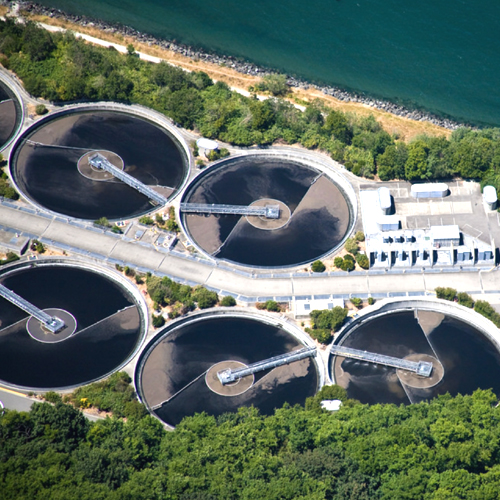Disinfection
Presently for disinfection chlorine or chlorine compounds are used, but
because of the potential DBP (Disinfection Byproducts) ozonation is rapidly
replacing the chlorination systems. In many places where ozone is used
primarily as disinfectant, indirect improvements in odor or suspended solids
removal were achieved. Further easily bio-degradable compounds are produced
from the remaining DOC (Dissolved Organic Compounds) in the effluent.
Oxidation Of Inorganic Compunds
Ozone reacts very aggressively with cyanide (CN). Cyanide is frequently used
in galvanic processes in the metal processing and electronic industries.
Nitrite (NO2) as well as sulfide (H2S/S2) removal from the effluent is
easier using ozone as both substances react aggressively with ozone. Nitrite
is a toxic compound. Fe2+ and Mn2+ compounds are rapidly converted into
filterable Fe (OH)3 and MnO (OH)2 due to ozone. The application is in the
beverage industry. Arsenic removal system also utilizes ozone for
pre-oxidation, as As-III is converted to As-V. Oxidation of organic
compounds: Full scale ozonation systems have been used to treat effluent
such as landfill leachates as well as effluent from the textiles,
pharmaceutical and chemical industries. The main pollutants associated with
these waters are refractory organics, which can be characterized as :
- Humid compounds (brown or yellow colored) and absorbable organic
halogens in the landfill leachates.
- Colored (poly-) aromatic compounds often incorporating considerable
amounts of metal ions in textile effluent
- Toxic or biocidal substances (e.g. pesticides) in the pharmaceutical
and chemical industries.
- Surfactants from cosmetic and other industries.
- COD and colored compounds in solutions of the pulp and proper
production.
Due to the complex nature of COD the ozonation stage is mostly operated
between two biological systems. An important advantage of this process
combination is that no secondary wastes are produced, as would be the case
of the ozone-bio process steps were substituted by an activated carbon
treatment.
Color Removal
Water appears colored when visible radiation is absorbed by dissolved
materials or when light is reflected by suspended solids. Colored water is
basically found at dye houses, textile concerns, food and beverage
processors, slaughter houses and other industrial plants. Many industries
have already started using ozone, which is a more powerful and a safer
substitute than chlorine for color removal. The best results are achieved
when water has been treated to lower BOD, COD and suspended solids (SS)
values so that the ozone reaction is primarily for color removal. Wastewater
is Ozonated after it exists from chemical or/and biological pretreatment at
a dosage from 50 mg/lit to 150 mg/lit. At these levels, color can be reduced
by 90 to 98%. The dosage simultaneously reduces chemical oxygen demand (COD)
by about 45%. (Small increases of BOD, 5 to 9%, may occur.)
Color removal efficiency depends on the ozone dosage, the feed's color
values, the wastewater type and temperature and water characteristics.
Temperature less than 30oC produce the optimum conditions for ozone
solubility. Ozone installations for this application represent a significant
capital cost, but offer lower operating expense than conventional treatment
using chemical coagulants. In addition to the cost of chemical, the
coagulant process generates sludge that requires disposal and further
expenditure. Generally, the investment for an ozone installation can be paid
back in 3 to 5 years, depending upon the size and other specifications.
Improved Coagulation & Turbidity Removal
Oxidation of dissolved organic materials by Ozone results in polar and
charged molecules that can react with Polyvalent Aluminum or Calcium to form
precipitates. Treatment of a surface water with up to 0.5 ppm of Ozone
results in a decrease in turbidity, improved settleability and a reduction
in the number of particles. Referred to as pre-ozonation this treatment
destabilizes the colloid with a resultant reduction of the amount of
coagulant needed to produce a clear filtrate. Ozone is effective against a
large variety of water treatment problems. In general, the more problems in
the water to be treated with ozone, the less an ozonation system costs when
compared to other more conventional treatment methods.


